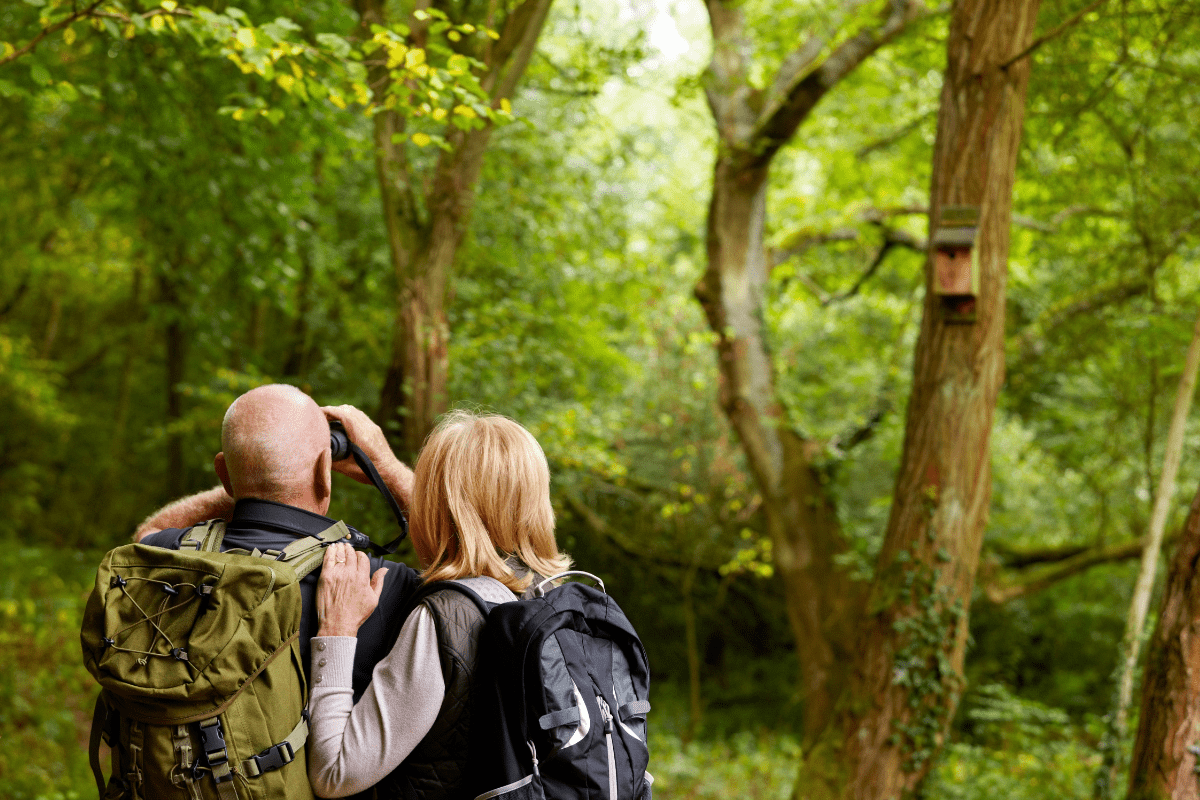Michigan's wildlife scene is like a nature documentary you can actually walk into, complete with bugling elk, prowling wolves, and more birds than you can shake a field guide at. From the moose-inhabited forests of the Upper Peninsula to the Great Lakes shorelines where endangered piping plovers nest, the state offers year-round opportunities to spot creatures both common and rare.
Whether you're hoping to glimpse a gray wolf or just want to photograph some seriously photogenic sandhill cranes, Michigan's 103 state parks and multiple wildlife refuges provide the perfect backdrop for your wild adventures.
Where the wild things really are
Michigan's best wildlife viewing spots read like a greatest hits album of natural wonders, each with its own headliner species and supporting cast of critters.
Upper Peninsula: Where moose might actually show up
The Seney National Wildlife Refuge reigns as Michigan's premier wildlife destination, sprawling across 95,238 acres of wetlands, forests, and "please don't get lost" wilderness. This refuge supports over 200 bird species and 50 mammal species, including moose, black bears, wolves, and river otters who apparently didn't get the memo about being elusive. The 7-mile Marshland Wildlife Drive offers viewing so good, you'll wonder if the animals are getting paid to pose. Between 200 and 250 trumpeter swans call this place home, turning what could be a simple drive into something resembling a Disney movie scene.
Tahquamenon Falls State Park combines Instagram-worthy waterfalls with 49,000 acres of wildlife habitat. The park hosts 125+ nesting bird species, and its 35 miles of hiking trails wind through forests where you might encounter black bears (from a respectful distance, please). The stretch of M-123 near the park has earned fame as one of Michigan's best locations for moose sightings. Just remember: seeing a moose is like finding a parking spot at Costco on Saturday… possible, but requires patience and timing.
Speaking of moose, Newberry has boldly declared itself the "Moose Capital of Michigan", which is a bit like declaring yourself the tallest person in your living room. Still, your odds of spotting these magnificent ungulates are better here than most places, especially if you're willing to wake up at ungodly hours and drive slowly along forest roads.
The elk situation (yes, Michigan has elk)
The Pigeon River Country State Forest serves as Michigan's unexpected "Elk Capital", supporting between 500 and 1,000 elk across 114,000 acres. The 2024 DNR aerial survey counted 1,146 elk, proving that yes, there really are elk in Michigan, and no, you're not hallucinating from too much pasty consumption. The forest features 13 designated viewing areas strategically placed where elk like to hang out and eat, which is basically their entire daily agenda.
Lower Peninsula highlights
Shiawassee National Wildlife Refuge near Saginaw proves that the Lower Peninsula can hold its own in the wildlife department. This 9,870-acre refuge has recorded 280+ bird species, earning designation as an Important Bird Area of global significance. The Ferguson Bayou Trail features observation towers with spotting scopes, because squinting at distant specks gets old fast.
Whitefish Point Bird Observatory takes spring migration seriously, recording over 25,000 raptors during peak season. If you've ever wanted to see more hawks than a political debate, this is your spot.
Timing is everything (and so is coffee)
Understanding Michigan's wildlife calendar transforms hopeful outings into successful sightings, assuming you can drag yourself out of bed early enough.
Fall: When elk get noisy
September through October represents peak wildlife drama season. Bull elk begin their bugling around September 20th, creating sounds that fall somewhere between a rusty gate and a lovesick dinosaur. The best viewing times are dawn and dusk during the rut, which unfortunately coincide with when normal humans prefer sleeping or eating dinner. The Rocky Mountain Elk Foundation confirms this is prime time for experiencing nature's version of speed dating, complete with antler clashing and competitive posturing.
Spring migration madness
Spring in Michigan brings bird migration that would make even non-birders grab binoculars. Mid-March kicks off with bald eagles and red-shouldered hawks heading north, followed by massive waterfowl movements through late March and April. The real show happens in early May when warbler species counts can jump from 12 to 30 overnight. It's like nature's version of a flash mob, except with more colorful plumage and better songs.
Bear facts worth knowing
Michigan's black bear population has grown to 12,000+ individuals, increasing 25% since 2012. The northern Lower Peninsula has seen a 55% population increase, which is great for ecosystem health but less great if you forget to secure your bird feeders.
Peak bear viewing happens during:
- Late April through May (post-hibernation munchies)
- September through October (pre-hibernation feast)
- Dawn and dusk (sensing a pattern here?)
- Near berry patches (obviously)
DNR wildlife biologist Jared Duquette notes that bears serve as "terrific seed dispersers", which is a polite way of saying they eat berries and poop forests.
Winter wildlife watching
Don't write off winter completely. Bald eagles, once down to 140 breeding pairs at their lowest point, have rebounded to approximately 900 pairs today. They concentrate near open water in winter, providing reliable viewing when you're desperate for any wildlife sighting that doesn't involve squirrels raiding your feeder. Plus, snow improves elk visibility, turning camouflaged giants into obvious brown shapes against white backgrounds.
Gear up or give up
Success in wildlife viewing requires proper equipment, unless you enjoy squinting at blurry distant shapes while pretending you definitely see that rare warbler everyone's excited about.
The optics situation
Professional wildlife photographers recommend binoculars in the 8×42 or 10×42 configuration. The 42mm objective lens diameter gathers enough light for dawn and dusk viewing while remaining portable enough that you won't feel like you're lugging bowling balls around your neck. Look for close-focus capabilities down to 2-3 meters, particularly useful for butterflies and other small creatures that won't trigger your "apex predator approaching" instincts.
Photography gear that won't break the bank (much)
For photography, you'll need at least 300mm of telephoto reach, though 400-600mm is ideal for maintaining safe distances while still getting frame-filling shots. Michigan's pros consistently recommend the Tamron 150-600mm G2 for its versatility across varied habitats and ability to make your camera look impressively professional at wildlife viewing areas.
Key camera settings for wildlife:
- Shutter speed: 1/1600-1/2000 for birds
- ISO: 800-1600 acceptable
- Aperture: f/2.8-f/4 for subject isolation
- Continuous autofocus (always)
- Weather sealing (non-negotiable in Michigan)
The tick situation requires attention
Protecting yourself from ticks isn't optional unless you enjoy playing "disease roulette" after every hike. Light-colored clothing makes the tiny vampires easier to spot, while long sleeves and pants tucked into socks create the "fashion-forward naturalist" look. Permethrin-treated clothing kills ticks on contact and remains effective through multiple washings, unlike your enthusiasm for 5 AM wildlife viewing.
The Michigan Department of Health offers free tick identification via email at MDHHS-Bugs@michigan.gov. Just photograph any attached tick and send it in for expert analysis and appropriate panic level determination.
Field guides for the modern age
While traditional guides like the Michigan Nature Set remain valuable, smartphone apps have revolutionized field identification. iNaturalist, Seek, and Merlin Bird ID provide instant identification help, turning your phone into a pocket naturalist who never judges your misidentification of that "definitely rare" house sparrow.
Navigating the red tape
Michigan makes accessing wildlife viewing areas relatively painless, assuming you understand the system and don't mind occasional bureaucracy.
Recreation Passport: Your golden ticket
The Recreation Passport costs just $14 annually for Michigan residents when purchased with license plate renewal, or $41 for non-residents. This modest fee provides unlimited access to all state parks and recreation areas. Veterans with special license plates receive free access, because some heroes wear camo for different reasons.
Accessibility options expand viewing opportunities
Michigan increasingly provides accessible wildlife viewing infrastructure. Tahquamenon Falls offers an accessible walkway to the Upper Falls viewing area, while Bond Falls provides an accessible boardwalk with six viewing locations. Many parks now loan track chairs, specialized wheelchairs that navigate trails like tiny tanks, opening backcountry areas to visitors with mobility challenges.
Photography permits and regulations
Personal wildlife photography requires no special permits, but commercial photography needs a $100 application fee. Some areas implement seasonal restrictions during nesting or hunting seasons. Check the DNR website for current closures, especially during spring migration when some areas temporarily close to protect breeding birds from enthusiastic photographers.
Playing it safe in the wild
Wildlife viewing should create memories, not medical bills or viral videos titled "Tourist Learns Why You Don't Pet Wild Animals."
The distance rule nobody follows (but should)
Large mammals require a minimum 100-yard buffer. Use the "rule of thumb" test: if you can't cover the animal with your thumb at arm's length, you're too close. Most other wildlife needs at least 25 yards of space. These aren't arbitrary numbers designed to ruin your Instagram shots… they're science-based distances preventing stress responses that waste animals' critical energy reserves.
When bears happen
Black bear encounters require specific responses that go against every human instinct. Don't run… bears can outrun you even on their worst day. Instead:
- Back away slowly
- Make yourself appear larger
- Speak calmly but firmly
- Avoid direct eye contact
- Carry bear spray (and know how to use it)
Tick prevention protocol
Post-adventure tick checks aren't optional. Shower within two hours and conduct thorough checks in warm, moist areas where ticks prefer to set up shop. Use EPA-registered repellents containing DEET or Picaridin on exposed skin, and treat clothing with permethrin for a double layer of protection.
Rare sightings and bragging rights
Some Michigan wildlife requires extra effort, luck, or both to spot, but the bragging rights last forever.
The wolf situation
Michigan's gray wolf population of 631 animals in 136 packs represents a conservation success story, though actually seeing one requires lottery-winning luck. Isle Royale National Park offers the highest probability, though even there, wolves remain masters of not being seen.
Kirtland's warbler: From near-extinction to viewable
This habitat specialist's recovery deserves its own movie. Michigan Audubon Society tours from May 24 through June 30 achieve remarkably high success rates. For $20, experienced guides lead small groups to active territories where males sing from exposed perches, apparently unaware they're supposed to be extinct.
Piping plovers: Tiny birds, huge comeback
These endangered shorebirds have rebounded from 12 pairs to 85 nesting pairs in 2025. Sleeping Bear Dunes provides primary viewing opportunities, with symbolic fencing protecting nests while allowing respectful observation from 25-50 yards.
Hidden gems for the adventurous
Peninsula Point near Rapid River hosts thousands of monarch butterflies during August and September migration. Fumee Lake Natural Area near Iron Mountain preserves 1,800 acres including a lake with mysteriously large fish visible from shore, the result of no recreational fishing for over a century.
Photography wisdom from the field
Award-winning photographer Steve Jessmore emphasizes "subject welfare over capturing images," which means no baiting, chasing, or otherwise harassing wildlife for the perfect shot. Forest photography requires spot metering and wide apertures (f/2.8-f/4) to manage extreme contrast between sunny spots and shadows. Accept higher ISOs… a sharp image with some noise beats a blurry one every time.
Making it happen
Michigan's wildlife viewing opportunities reward preparation and patience. The state hosts numerous festivals, from the Tawas Point Birding Festival to the Kirtland's Warbler Festival, combining guided tours with expert knowledge. Citizen science programs let you contribute to conservation while improving observation skills.
Success comes from understanding seasonal patterns, respecting wildlife, and accepting that nature operates on its own schedule. Whether seeking federally endangered species or simply enjoying common creatures in spectacular settings, Michigan's protected lands offer experiences ranging from drive-up easy to wilderness challenging. Pack your binoculars, charge your camera batteries, and remember: the early birder gets the warbler, but the patient viewer gets the stories worth telling.



